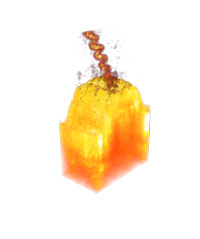By
Beckman Institute
Published on
Nov. 11, 2013
Keith Cassidy
The Bacterial Brain: Looking into a Chemoreceptor Array
The ability of all living things, from single cells to large multicellular organisms, to sense and interpret environmental signals is central to life. Bacteria have evolved exquisite protein networks, which they use to detect spatial gradients in certain chemicals in their surroundings and appropriately alter their swimming behavior. This computation is carried out within the chemoreceptor array, a remarkably ordered supramolecular complex composed of the histidine kinase, CheA; adaptor protein, CheW; and various methyl‐accepting chemotaxis proteins (MCPs), which cluster together by the thousands at the cell pole. The clustering of receptors within the chemoreceptor array gives rise to the systems‐level information processing properties of bacterial chemotaxis such as signal amplification, ultrasensitivity, and precise adaptation. We present an all‐atom structure of the chemoreceptorarray from the thermophile Thermotoga maritime, derived from computational and experimental techniques. The structure suggests a possible molecular mechanism for signal transduction through the array and its functional implications.
Nathan Shemonski
In vivo Computed Optical Interferometric Tomography
Obtaining high-quality, high-resolution 3D tomograms can be difficult due to imperfections in optical elements and the divergent nature of light. To overcome these challenges, complex and expensive adaptive optics setups or non-traditional beams shapes have been utilized. In this talk, I will present the capabilities of using the phase in interferometric imaging as a more accessible alternative to correcting optical aberrations and defocus when imaging living samples. Historically, these techniques have been limited to fixed or static samples. With recent advances in speed and sensitivity, it has been possible to extend these techniques to living samples such as the skin and possibly the eye. These demonstrations dramatically increase the potential for computed optical interferometric techniques to be used in clinical applications and long-term research studies.
Eric Drollette
The Differential Relation of Sex on Fitness and Working Memory in Pre-pubertal Children
Previous investigations have indicated that fitness enhances working memory among preadolescent children. However, few studies have systematically explored fitness-related differences among key demographic characteristics, such as sex, which have been shown in previous research to influence working memory performance. The present investigation examined the differential relation of sex to cardiorespiratory fitness on working memory in preadolescent children (8-10 years old). Data were collected during three separate studies (n=114 [53 female], n=103 [51 female], n=101 [45 female]), using separate and unique tasks that tap different aspects of working memory (i.e., operation span task, n-back task, Sternberg task). Participants also completed a cardiorespiratory fitness test to assess maximal aerobic capacity (i.e., VO2max). Hierarchical regression analyses were conducted separately on males and females. Results from all three studies revealed a positive relation of fitness on working memory that was selective for males; a relationship not observed for females. Further, these results were only evident for task conditions necessitating greater working memory demands. The findings are consonant with previous literature and reveal new evidence that fitness may selectively modulate working memory, specifically for developing male children. This investigation also provides unique insight into how interventions aimed at improving fitness may influence cognitive development differentially among males and females and further demonstrates the need for individualized physical activity programs.

